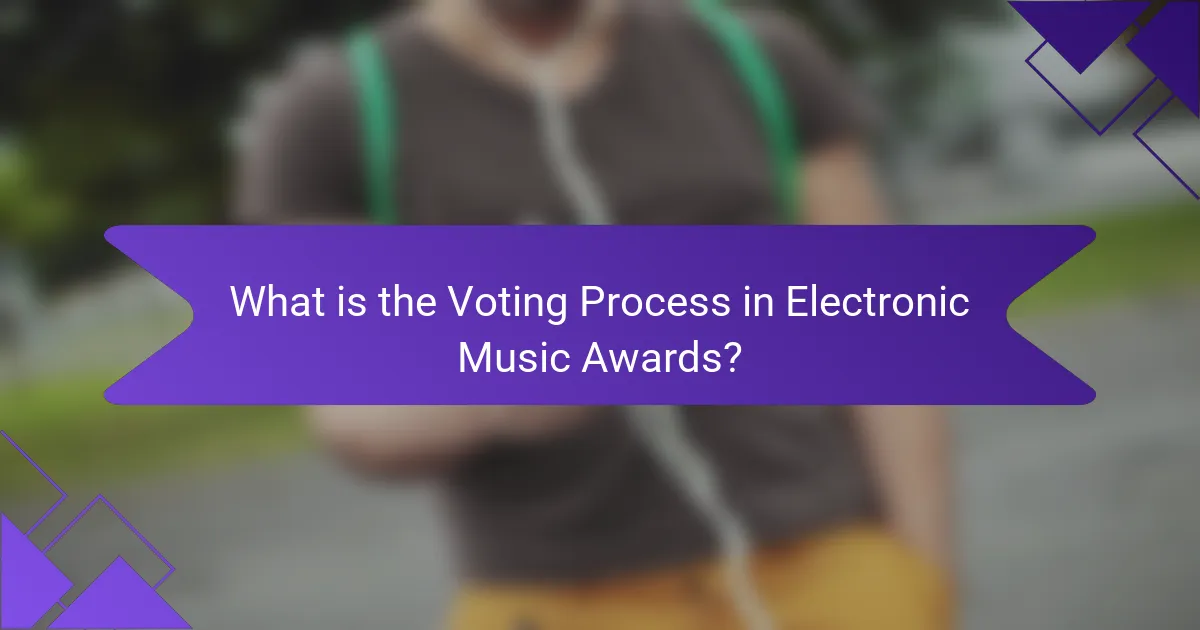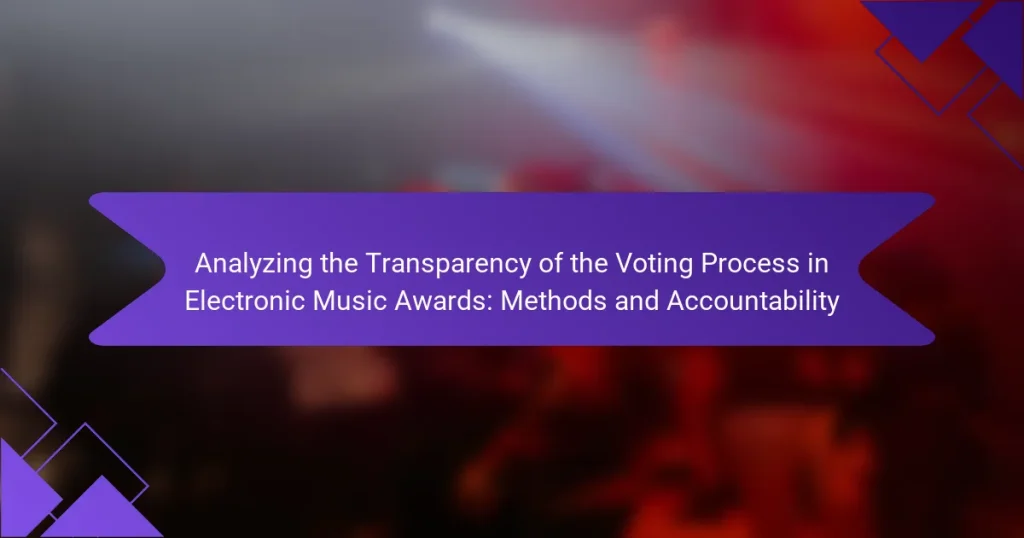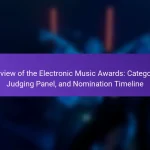The Electronic Music Awards voting process involves several key steps designed to ensure transparency and fairness. Eligible voters, including industry professionals and fans, first register on the official website before nominations are submitted for artists and tracks. Following the nomination period, registered voters cast their votes online, with secure technology used to tally the results accurately. The final results are announced during the awards ceremony, emphasizing the importance of accountability in the selection of winners. This article analyzes these methods to highlight the integrity of the voting process in the Electronic Music Awards.

What is the Voting Process in Electronic Music Awards?
The voting process in the Electronic Music Awards involves several key steps. First, eligible voters register through the official website. Voters typically include industry professionals and fans. Next, a nomination period occurs where artists and tracks are submitted for consideration. After nominations, a voting phase begins. This phase allows registered voters to cast their votes online. Votes are usually tallied using secure technology to ensure accuracy. Finally, results are announced during the awards ceremony. This process aims to maintain transparency and fairness in the selection of winners.
How is the voting process structured in Electronic Music Awards?
The voting process in the Electronic Music Awards is structured through a combination of public and industry voting. Fans can cast their votes online for their favorite nominees. This public voting component accounts for a significant portion of the total score. Industry professionals also participate in the voting process. Their votes are weighted differently to reflect their expertise. The final results are a blend of both public and industry votes. This dual approach aims to ensure fairness and representation. Transparency is maintained by publishing voting results after the event. This structure enhances accountability within the awards process.
What are the key stages of the voting process?
The key stages of the voting process include voter registration, ballot casting, and vote counting. Voter registration is the first step where individuals sign up to participate in elections. This process often requires providing personal information and sometimes proof of identity. Once registered, voters receive information about where and when to vote.
Ballot casting follows, where voters select their preferred candidates or options on a ballot. This can occur in person, by mail, or through electronic means. The method of casting a ballot may vary by jurisdiction.
After ballots are cast, the vote counting stage begins. Election officials tally the votes to determine the outcome. This process must be transparent to ensure public trust in the results. Each stage is crucial for maintaining the integrity and accountability of the electoral process.
How do participants engage in the voting process?
Participants engage in the voting process by casting their votes through designated platforms. These platforms often include online voting systems or mobile applications. Voters typically register before the voting period begins. Once registered, they can access the voting interface during the specified voting window. Participants select their preferred nominees and submit their choices electronically. This method ensures a streamlined and efficient voting experience. Transparency is maintained through secure systems that track votes. Data from previous awards shows that electronic voting can increase participation rates significantly.
Why is Transparency Important in the Voting Process?
Transparency is important in the voting process because it builds trust in electoral outcomes. When voters can see how their votes are counted, they feel more confident in the legitimacy of the results. Transparency helps to prevent fraud and manipulation. It allows for scrutiny by independent observers and stakeholders. Studies show that transparent processes increase voter participation. For example, the National Democratic Institute found that transparency can enhance public confidence in elections. Moreover, transparency promotes accountability among election officials. When processes are clear, officials are less likely to engage in misconduct. Overall, transparency is essential for a fair and democratic voting process.
What are the potential risks of a non-transparent voting process?
A non-transparent voting process can lead to significant risks such as manipulation and fraud. Without transparency, the integrity of the election can be compromised. Voters may lose trust in the outcomes. This distrust can result in lower participation in future elections. Additionally, it can create opportunities for biased decision-making. Historical examples show that opaque processes often result in allegations of unfairness. Transparency is essential for accountability and public confidence. Studies indicate that transparent processes enhance voter engagement and trust.
How does transparency enhance trust among voters and nominees?
Transparency enhances trust among voters and nominees by providing clear information about the voting process. It allows voters to understand how their votes are counted and ensures fairness. When nominees see that the process is open, they feel more secure in the integrity of the system. Transparency reduces the potential for manipulation or bias. Research shows that when voters perceive a transparent process, they are more likely to participate. A study by the Pew Research Center found that 80% of voters believe transparency is crucial for trust in elections. This trust can lead to higher voter engagement and satisfaction with the outcomes.
What Methods are Used to Ensure Transparency in the Voting Process?
Methods used to ensure transparency in the voting process include independent audits, public access to results, and the use of verifiable voting systems. Independent audits involve third-party organizations reviewing the voting process and outcomes for accuracy. Public access to results allows stakeholders to verify the tallies independently. Verifiable voting systems provide a paper trail that can be checked against electronic votes. These methods collectively enhance trust in the voting process by ensuring accountability and accuracy.
What technologies are implemented to secure the voting process?
Technologies implemented to secure the voting process include encryption, blockchain, and biometric authentication. Encryption safeguards data during transmission and storage, preventing unauthorized access. Blockchain technology ensures transparency and tamper-proof records of votes. Biometric authentication verifies voter identity using unique biological traits. These technologies collectively enhance security and integrity in the voting process. They are increasingly adopted in various voting systems to mitigate risks of fraud and ensure accurate results.
How are votes verified and counted in Electronic Music Awards?
Votes in the Electronic Music Awards are verified through a secure online voting platform. This platform employs encryption to ensure the integrity of each vote. Voter identities are authenticated using unique identifiers. After the voting period ends, the votes are counted by an independent auditing firm. This firm ensures that the counting process is transparent and free from tampering. Results are then published publicly to maintain accountability. The use of third-party verification enhances trust in the voting process.
How is Accountability Maintained in the Voting Process?
Accountability in the voting process is maintained through various mechanisms. These include secure voting systems, transparent procedures, and independent audits. Secure voting systems prevent tampering and ensure the integrity of votes. Transparent procedures allow stakeholders to understand how votes are collected and counted. Independent audits verify the accuracy of the voting results. These audits often involve cross-checking the results against the original votes. Additionally, public reporting of results enhances accountability by allowing scrutiny. Together, these measures ensure that the voting process is fair and trustworthy.
What roles do independent auditors play in ensuring accountability?
Independent auditors play critical roles in ensuring accountability. They provide an objective assessment of financial statements and processes. This assessment helps to verify the accuracy of reported information. Independent auditors also evaluate compliance with laws and regulations. Their work enhances the credibility of the voting process. By identifying discrepancies or weaknesses, they promote transparency. Their findings can lead to improvements in governance and oversight. Ultimately, independent auditors help build trust among stakeholders.
How is feedback from participants incorporated into the process?
Feedback from participants is incorporated into the voting process through structured surveys and focus groups. These methods allow participants to express their opinions and experiences. Surveys collect quantitative data on participant satisfaction and suggestions for improvement. Focus groups provide qualitative insights and foster in-depth discussions about the voting experience. The data gathered is analyzed to identify trends and areas for enhancement. Changes to the voting process are then implemented based on this feedback. This approach ensures that participant voices are heard and considered in decision-making. Regular updates are communicated to participants about how their feedback has influenced changes. This transparency fosters trust and encourages ongoing engagement in future voting processes.
What Challenges are Faced in Maintaining Transparency and Accountability?
Maintaining transparency and accountability in the voting process faces several challenges. One significant challenge is the complexity of electronic voting systems. These systems often involve intricate algorithms that can obscure the decision-making process. A lack of understanding among voters can lead to mistrust. Additionally, data security concerns can compromise the integrity of the voting process. Cybersecurity threats may manipulate or alter votes, undermining accountability. Furthermore, insufficient oversight mechanisms can allow discrepancies to go unchecked. Lastly, stakeholder engagement is often limited, reducing the effectiveness of transparency initiatives. These factors collectively hinder efforts to ensure a fair and accountable voting process.
What common issues arise during the voting process?
Common issues during the voting process include voter fraud, technical malfunctions, and misinformation. Voter fraud can occur when individuals cast multiple votes or impersonate others. Technical malfunctions may disrupt the voting system, leading to lost or miscounted votes. Misinformation can spread through social media, misleading voters about the voting process or candidates. According to a 2020 study by the Brennan Center for Justice, 27% of voters reported issues with voting machines. These issues can undermine the integrity and transparency of the voting process.
How can these challenges be effectively addressed?
Implementing transparent voting systems can effectively address challenges in the voting process of Electronic Music Awards. Utilizing blockchain technology ensures that votes are securely recorded and easily verifiable. This technology creates an immutable ledger, which enhances trust among participants. Regular audits of the voting system can identify discrepancies and reinforce accountability. Engaging independent third parties to oversee the process adds an extra layer of credibility. Clear communication of voting procedures to all stakeholders is essential for transparency. Additionally, providing real-time updates on the voting status can alleviate concerns about manipulation. These methods collectively enhance the integrity of the voting process.
What Best Practices Can Enhance the Transparency of the Voting Process?
Best practices to enhance the transparency of the voting process include clear communication of voting rules and procedures. This ensures all participants understand how the process works. Regular updates during the voting period can also maintain engagement and trust among voters.
Implementing independent audits of the voting process can provide external verification of results. Using secure and verifiable voting technologies increases confidence in the integrity of the votes cast.
Publicly sharing the results and the methodology used to calculate them fosters accountability. Providing a platform for feedback from voters can address concerns and improve future processes.
These practices are supported by studies showing that transparency increases voter confidence and participation. For example, the National Democratic Institute found that transparent processes lead to higher public trust in electoral outcomes.
How can organizers improve communication about the voting process?
Organizers can improve communication about the voting process by utilizing multiple channels for information dissemination. They should employ social media platforms to reach a wider audience quickly. Regular updates can be shared through email newsletters to keep stakeholders informed. Clear, concise guidelines should be published on official websites for easy access. Hosting informational webinars can provide a platform for direct interaction and questions. Visual aids, such as infographics, can simplify complex information about the voting process. Feedback mechanisms should be established to gauge understanding and address concerns. Transparency in communication fosters trust and encourages participation. Studies show that effective communication increases voter engagement by up to 30%.
What measures can be taken to educate voters about their rights?
Voter education can be enhanced through various measures. First, organizations can conduct workshops to inform voters about their rights. These sessions can cover topics such as voter registration and polling procedures. Second, distributing informative materials like brochures and flyers can reach a wider audience. These materials should clearly outline voters’ rights and responsibilities. Third, utilizing social media platforms can effectively engage younger voters. Online campaigns can share vital information quickly and broadly. Fourth, partnerships with local community groups can help spread awareness. Collaborating with trusted organizations can increase credibility. Finally, implementing educational programs in schools can instill knowledge early. Teaching students about voting rights prepares them for future participation. These measures can significantly improve voter awareness and engagement.
What Future Trends May Impact the Voting Process in Electronic Music Awards?
Future trends that may impact the voting process in Electronic Music Awards include blockchain technology, social media integration, and AI-driven analytics. Blockchain can enhance transparency and security in vote tallying. This technology ensures that votes are immutable and verifiable. Social media platforms can facilitate wider engagement and real-time voting. They allow fans to participate directly, increasing the awards’ visibility. AI-driven analytics can provide insights into voting patterns and preferences. This data can help organizers refine the voting process. Overall, these trends aim to increase transparency and accountability in the voting process.
How might emerging technologies change the voting landscape?
Emerging technologies may significantly alter the voting landscape by enhancing accessibility and security. Innovations such as blockchain can ensure transparent and tamper-proof voting records. Biometric identification methods can improve voter authentication and reduce fraud. Online voting platforms can increase participation by allowing remote access. Artificial intelligence can analyze voting patterns and improve the efficiency of the electoral process. According to a 2020 study by the National Institute of Standards and Technology, blockchain can enhance the integrity of election results. These technologies collectively aim to create a more secure, efficient, and inclusive voting environment.
What role will social media play in future voting processes?
Social media will play a significant role in future voting processes by enhancing voter engagement and information dissemination. Platforms like Twitter and Facebook can facilitate real-time communication between voters and organizers. This instant interaction can increase transparency in the voting process. Additionally, social media can serve as a tool for educating voters about the voting procedure. Studies show that social media campaigns can effectively mobilize younger voters. For example, the 2020 U.S. elections saw a notable increase in voter turnout among millennials due to social media efforts. Furthermore, social media can provide a space for feedback and accountability, allowing voters to voice concerns and report irregularities. Overall, the integration of social media in voting processes can lead to more informed and engaged electorates.
How can Participants Get Involved in the Voting Process?
Participants can get involved in the voting process by registering to vote and casting their ballots. Voter registration typically requires providing personal information, such as name and address. Many voting platforms offer online registration for convenience. Participants should check registration deadlines to ensure they are eligible to vote. Once registered, they can access the voting platform during the voting period. Voting may involve selecting nominees or categories relevant to the Electronic Music Awards. Participants can also engage in discussions on social media to promote awareness of the voting process. This involvement helps increase transparency and accountability in the awards’ voting system.
What steps should voters take to ensure their voices are heard?
Voters should register to vote and verify their registration status. This ensures they are eligible to participate in elections. Voters must educate themselves about the candidates and issues on the ballot. Knowledge empowers informed decision-making. They should participate in early voting or vote on election day. This increases the likelihood of their participation. Voters can also engage in discussions with others to share their views. This can amplify their voices within their communities. Lastly, voters should provide feedback to election officials about the voting process. This helps improve future elections and ensures accountability.
How can nominees promote transparency during the voting process?
Nominees can promote transparency during the voting process by clearly communicating their intentions and actions. They should openly share information about their campaign strategies. This includes detailing how votes will be collected and counted. Nominees can also advocate for independent audits of the voting process. Engaging with voters through Q&A sessions fosters trust and clarity. Providing regular updates on voting procedures ensures all participants are informed. Transparency in their own voting records can further enhance credibility. Implementing feedback mechanisms allows for community input on the process. These steps collectively build a transparent voting environment, essential for fair recognition in awards.
The main entity of this article is the voting process in the Electronic Music Awards, which emphasizes transparency and accountability. The article outlines the structured voting process, including voter registration, nomination, and ballot casting, while detailing the importance of transparency in building trust among voters and nominees. It examines the methods used to ensure transparency, such as independent audits and secure technologies, and discusses the challenges faced in maintaining accountability. Additionally, it highlights future trends and best practices that could enhance the voting process, ultimately aiming to foster greater engagement and integrity within the awards system.


